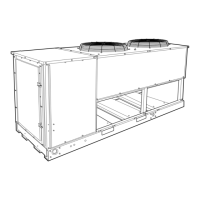
Do you have a question about the Carrier 38AKS028-044 and is the answer not in the manual?
| Refrigerant | R-410A |
|---|---|
| Phase | 3 |
| Compressor Type | Scroll |
| SEER Rating | 13 SEER |
| Voltage | 208/230 V |
| Weight | 150 kg |
Ensure 4 ft (1220 mm) service space and 8 ft (2440 mm) clear air space above unit for proper placement.
Use base rail mounting holes for securing to structure or vibration isolators. Mount unit level for oil return.
Compressor is secured by four bolts; loosen them after installation to allow flatwasher movement.
Select line sizes based on piping length and evaporator, considering liquid lift and compressor oil return.
Install factory solenoid at indoor unit to keep refrigerant on high-pressure side during off-cycle, minimizing migration.
Field-install a filter drier and sight glass for moisture indication to ensure system integrity.
The unit is not provided with a receiver, and its use is not recommended by the manufacturer.
Use nitrogen during brazing to prevent oxide formation and install TXV in liquid line ahead of each evaporator section.
Before starting, check auxiliary components, electrical connections, oil level, and perform leak testing and dehydration.
Leak test the entire refrigerant system and dehydrate it as per Carrier Training Booklet procedures for system integrity.
Charge the system with approximately 25 lbs (11.3 kg) of R-22 via the liquid charging method for initial operation.
Close disconnect, set thermostat above ambient, energize crankcase heater for 24 hours, then close breaker and reset thermostat.
Conduct charging under supervision, measuring pressure and liquid line temperature against the charging chart.
Follow control circuit diagrams; ensure the indoor fan system operates during charging or refrigerant removal.
The CM manages anti-short-cycle timing, oil pressure, high-pressure, and thermal protection for the compressor.
Unit features access panels and a front door for servicing compressor, refrigerant system, and electrical controls.
Access to the compressor compartment is via two side panels and a front door for component servicing.
Manually reset OPS is accessed by removing the left side access panel; open breaker before removing cover.
BPR provides a 2-minute LPS bypass and energizes unloaders for unloaded compressor start-up.
Factory-set TDR provides a 1-second delay for part-wind start, controlled by dip switch settings.
Details unit start-up, fan cycling, compressor loading/unloading, and shutdown based on thermostat and safety devices.
Explains causes of stoppage (power interruption, over-temp, HPS) and the restart process.
Adjust fan position on the motor shaft using the setscrew to ensure secure tightening.
Compressors are factory charged with oil; use only Carrier-approved oil for any additional oil or complete charge.
Located inside the compressor compartment, this valve has a 1/4-in. flare connection for field charging.
Controlled by suction pressure actuated unloaders; factory settings may be adjusted for desired control set point.
Maintains adequate discharge pressure under low ambient temperatures using fan cycling.
This switch has fixed, non-adjustable settings and is mounted on the compressor.
This switch has fixed, non-adjustable settings and is mounted on the compressor.
Lists probable causes like tripped breaker, open power, or defective motor, with corresponding remedies.
Probable causes include closed suction valve or low refrigerant; remedies involve opening valves or adding refrigerant.
Causes like closed discharge valve or non-operating fans require valve opening or fan checks.
Potential causes are low refrigerant, fused contacts, or air in system; remedies include adding refrigerant or replacing controls.
Probable causes are piping vibration or compressor noise; remedies involve supporting piping or checking valve plates.
Caused by system leaks or unenergized crankcase heaters; remedies involve leak repair or heater checks.
Caused by expansion valve admitting excess refrigerant; remedy is to adjust the expansion valve.
Caused by refrigerant shortage or expansion valve opening too wide; remedies are leak repair or expansion valve adjustment.
Caused by a restricted filter drier; remedy is to remove or replace the restriction.
Probable causes are defective unloaders or solenoid valves; remedies include replacement or rewiring.
Probable causes are miswired solenoid or unloader issues; remedies involve rewiring, replacing valve, or cleaning parts.
Collects essential unit details including model, serial numbers, and any additional accessories installed.
Checks for shipping damage, verifies power supply, ground wire, circuit protection, wiring, and compressor holddown bolts.
Verifies thermostat and indoor fan control wiring connections, terminal tightness, and crankcase heater energization.
Checks drain pan for proper drainage, air filters, pulley alignment, and fan belt tension for safe operation.
Confirms solenoid valve location, performs leak checks, ensures service valves are open, and checks oil sight glass levels.
Calculate voltage imbalance and do not start the system if imbalance exceeds 2%.
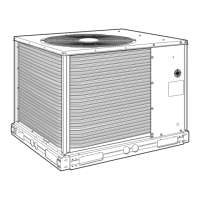
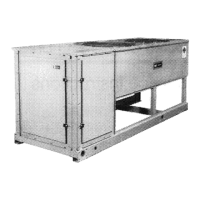
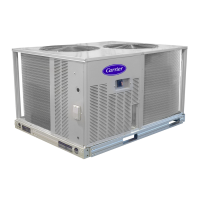





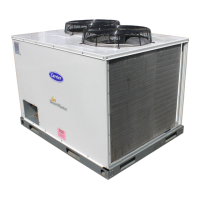
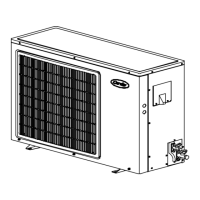
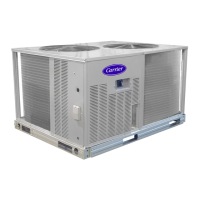
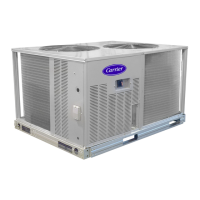
